The next-gen MacBook Pro with Retina Display Review
by Anand Lal Shimpi on June 23, 2012 4:14 AM EST- Posted in
- Mac
- Apple
- MacBook Pro
- Laptops
- Notebooks
The King of All Notebook Displays
For years Apple has been shipping some of the best displays in consumer notebooks, but the MacBook Pro’s Retina Display is in a league of its own. While I never liked the phrase “painted on” in reference to the iPad and iPhone Retina Displays, that’s the best way I can describe the effect the MacBook Pro’s Retina Display has on me. Text really does look painted on. The effect is really the result of two things.
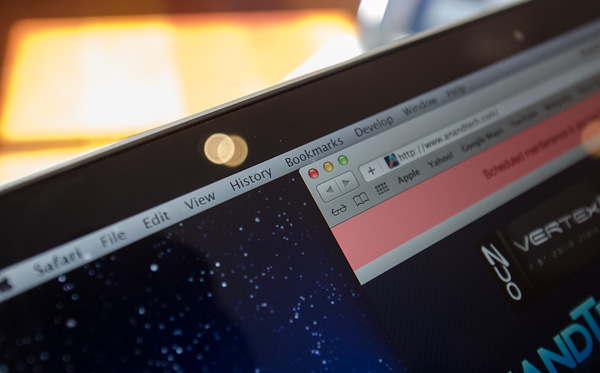
The first is Apple’s removal of its cover glass. LCD panels aren’t particularly attractive, they are ugly squares composed of two pieces of glass and a number of filters/polarizers. To hide the ugly edges, display makers wrap bezels around the display. Most people aren’t fond of bezels so next came a ton of effort to minimize bezel size. An alternative is to simply place a third piece of glass over the entire LCD assembly and make it look as if the bezel and LCD panel are integrated. This outermost layer is known as a cover glass and is what Apple uses on all of its glossy displays. If you’ve ever taken apart a Cinema/Thunderbolt Display or a newer iMac you’ll know that the cover glass is literally just a piece of glass that you have to remove with some suction cups.
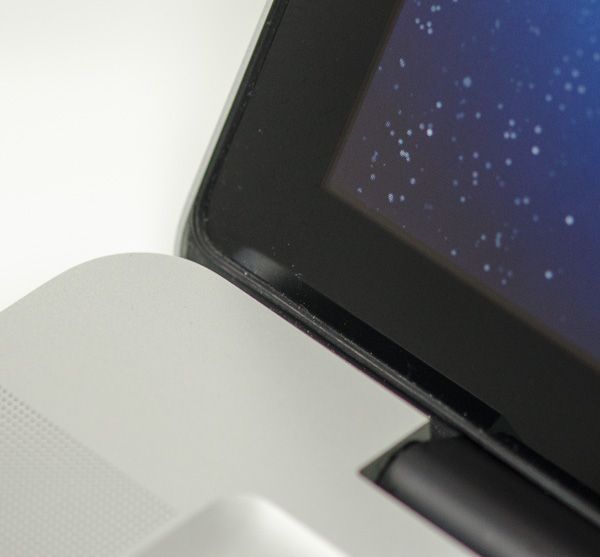
Non-Retina MacBook Pro, notice the gap between the outermost LCD glass and the cover glass
The MacBook Pro’s Retina Display does away with the cover glass and instead uses a fairly unique LCD assembly. There are still two pieces of glass but the outermost glass is actually a different size and shape - it integrates a bezel. By integrating the bezel into the outermost glass in the LCD stack you get the same effect as a cover glass but without the added reflections it introduces.
You also limit the possibility of dust getting trapped between the cover glass and the LCD. The danger is that you no longer have a protective piece of glass in front of your expensive new LCD. If you scratch the display you're scratching the LCD itself. While this has been true for conventional matte displays for a while, it's worth mentioning if you're used to Apple's glossy displays where you did have that added security layer.
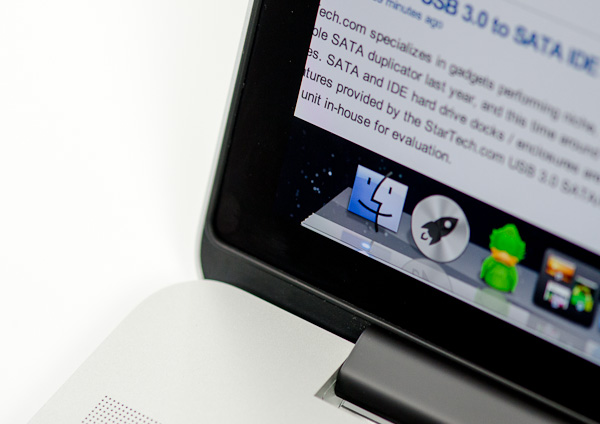
The MacBook Pro with Retina Display, no gap, no cover glass
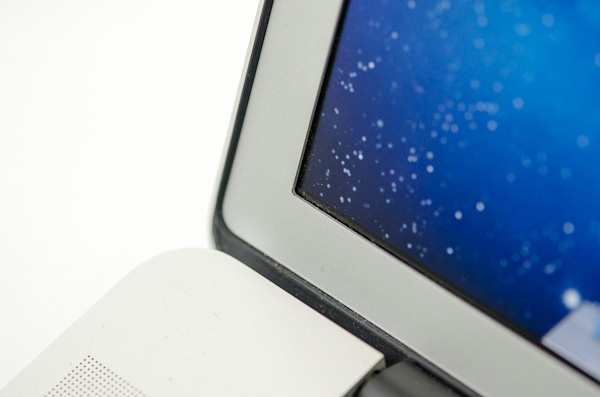
The 2011 MacBook Pro with High-Res Matte display option, no cover glass, top bezel

From left to right: 2010 High Res Glossy MBP, 2012 rMBP, 2011 High Res Matte MBP
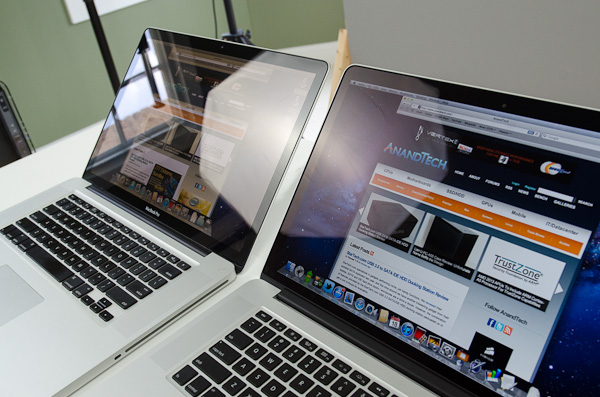
Glare handling indoors - 2011 High Res, Glossy MBP (left) vs 2012 rMBP (right)
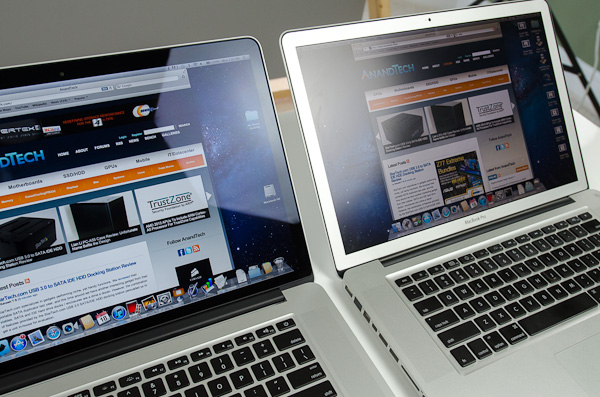
Glare handling indoors - 2012 rMBP (left) vs. 2011 High Res, Matte MBP (right)
The Retina Display is also obviously an extremely high resolution panel at 2880 x 1800. Note that this is 44.6% more pixels than Apple’s 27-inch Thunderbolt Display, and 26.6% more pixels than the 30-inch panels that we’ve loved for so long - all in a 15.4-inch notebook display.
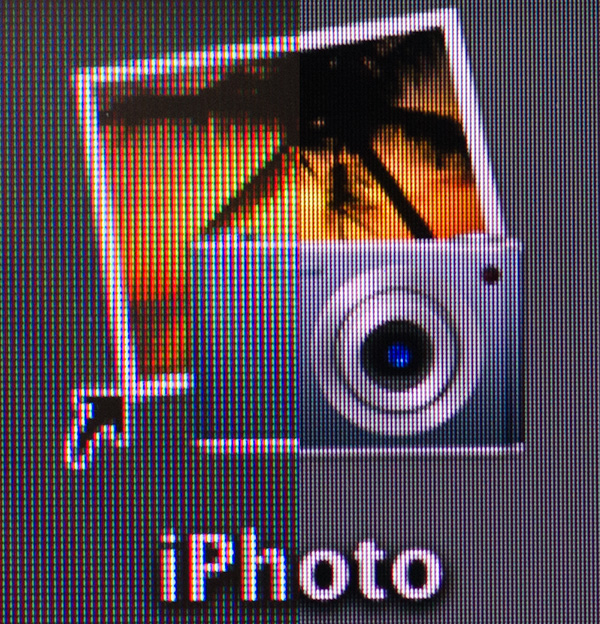
An iPhoto shortcut, High Res 2011 MBP (left) vs. Retina Display MBP (right)
At 220 pixels per inch it’s easily the highest density consumer notebook panel shipping today. At normal viewing distances and even with my face closer than I’m comfortable putting it I simply cannot discern individual pixels.
It’s the combination of these two elements, the removal of the cover glass and the insanely high pixel density that makes everything from text to UI elements just look painted on the new Retina Display. And the effect is gorgeous. I’ve never seen a prettier panel and it’s actually ruined me for pretty much all other displays, notebook and desktop.
While I can appreciate the iPad’s Retina Display, the impact from the MacBook Pro’s display is even more significant. Perhaps it’s because I still spend so much time working on a standard, non-tablet display, but I’m far more excited about this display than anything else Apple has delivered under the Retina moniker.
It’s not just pixel density that Apple has to offer here. Similar to its Retina Displays in the iPhone and iPad, the MacBook Pro’s Retina panel ditches TN in favor of IPS technology. The result is an incredible improvement in viewing angles. On a notebook I don’t spend a lot of time viewing it from far left/right angles, although I see the benefit when I’ve got others huddled around my display. Here the panel performs admirably - you lose brightness at far left/right angles but there’s no perceivable color shift. In fact, the painted on effect is even more impressive at these far left/right viewing angles.
For a single user however the more impressive characteristic is just how good the display looks at vertically off-center angles. I wrote much of the initial parts of this review while on an airplane in coach, which with a 15-inch notebook on my lap means I’m going to be looking at the display at a weird angle to begin with. The thinner rMBP doesn’t do enough to make the airplane usage model any better if the person in front of you decides to recline, but the IPS panel does make the display perfectly usable at the off-center angle you’ll inevitably have to deal with.
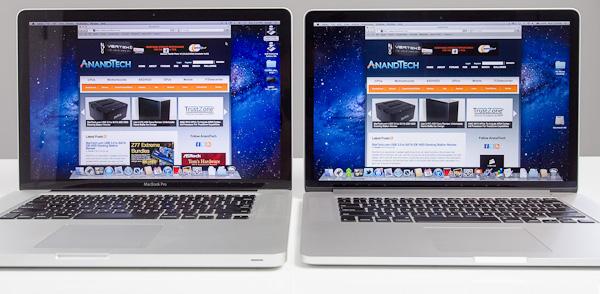
2010 High Res, Glossy MBP (left) vs. 2012 rMBP (right)
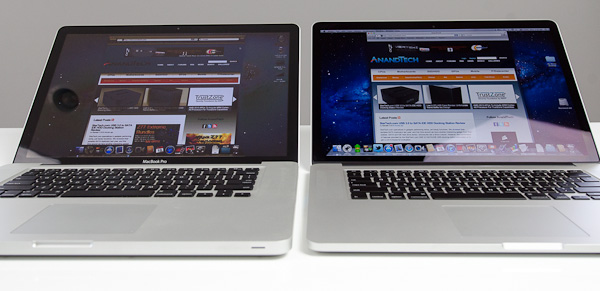
Hello colorshift!
2010 High Res, Glossy MBP (left) vs. 2012 rMBP (right)


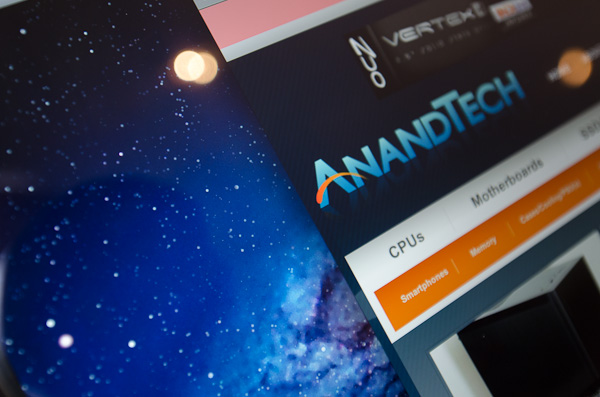
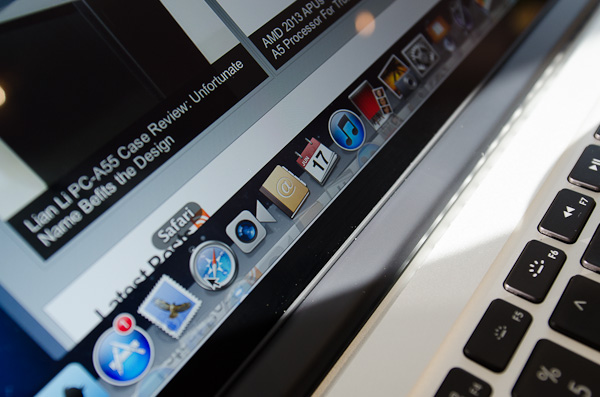
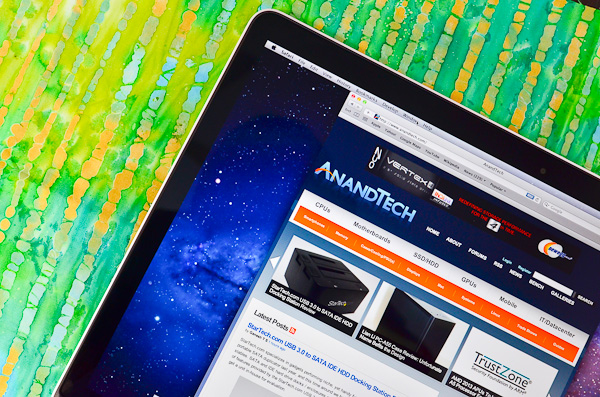
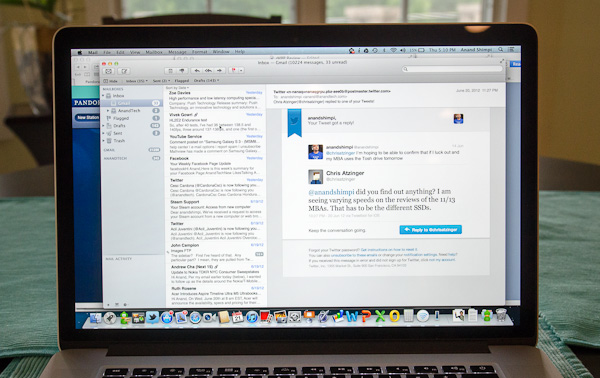
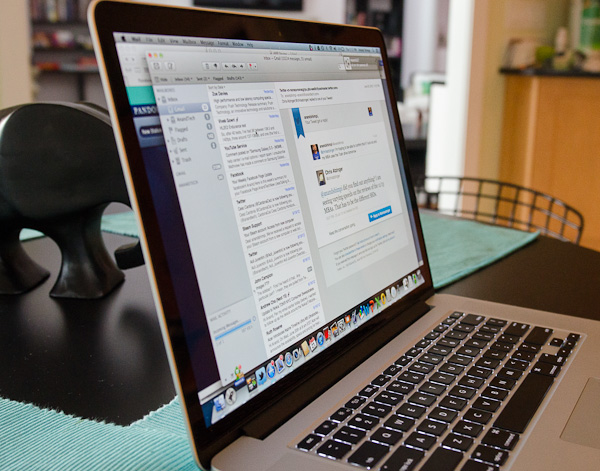








471 Comments
View All Comments
iCrunch - Sunday, June 24, 2012 - link
Agreed. This review is awesome. I hope he's right about the 4K Retina Thunderbolt display, which I'd buy in a heartbeat. One thing I don't get is why so many people and reviewers alike consider the $2,200 price tag extremely and often times too expensive. You're getting the latest and the greatest processors, both CPU and GPU-wise, a generous 8GB of RAM and I find the 256GB SSD to be plenty. After my two 180GB Intel 520 SSD's, this is the largest single SSD that I have ever owned. The upgrades are fair as well as far as doubling the RAM for $200 is concerned. At Apple no less! A few months ago, any setup of 16GB of RAM in 2 SODIMM's was well over $300 and if you go back a few more months, that amount of RAM set you back over a full grand! As in $1,000+I couldn't justify the $600+ price difference for an extra 300MHz in CPU clock and an additional 256GB Flash, though. If the GPU had come with 2GB GDDR5, then maybe, but not as it stands today.
hyrule4927 - Sunday, June 24, 2012 - link
First of all, the 650M may be one of the latest mobile GPU's, but it is pretty far from the greatest. It is a midrange GPU forced to drive an insane resolution with only 1GB of VRAM. And 8GB of RAM isn't "generous", to have any less in a laptop this expensive would be ridiculous. Paying $200 to upgrade to 16GB is a scam, especially considering Apple made the decision to prevent consumers from simply purchasing and installing more RAM on their own (you can find 2X8GB SODIMMs for a bit over $100, no idea what planet you were shopping on where that would cost $1000 at any time in the past year).EnerJi - Sunday, June 24, 2012 - link
I'm sure you can find 8GB of no-name stuff on sale somewhere, but for one example of name-brand memory, Crucial memory goes for $86.99 per 8GB ($173.98 total):http://www.crucial.com/store/listmodule/DDR3/list....
Also, Apple uses low-voltage DDR3-1600, which is lower volume and may be slightly more expensive as a result.
In that light, while $200 to upgrade to 16GB isn't exactly a bargain, it isn't the typical rapacious Apple upgrade prices.
Fx1 - Monday, June 25, 2012 - link
ARE YOU KIDDING? The 650M is running at 900mhz stock! people are clocking this bad boy well over 1050-1100mhzThose are ABOVE 660M GTX Speeds.
Id say Apple has packed in the BEST GPU possible given the thermal limits and size of this notebook.
In windows this MBP will run games at very nice settings and maybe the first Notebook that isn't as thick as an encyclopaedia that can run games on high settings.
Most will never use 8GB of Ram and 16GB is an option so i don't see the issue. Its also custom made which means Walmart RAM prices aren't compatible
hyrule4927 - Monday, June 25, 2012 - link
No, I'm not kidding. Nice capitalization though, it really does wonders for the credibility of your statements. Here are the flaws in your logic. You say that the 650M is the "BEST GPU possible given the thermal limits” with carefully placed capitalization in order to play down the qualifying terms in your statement. Then you suggest overclocking it. If Apple chose this GPU because they were fighting thermal limits, do you really expect it to handle overclocking well? And sure it can run Half Life 2 and Diablo III (an old game, and a game that is hardly demanding by modern standards) at standard resolutions, but users are going to want to game at native resolution on their new retina screen. Too bad Diablo runs at 18 frames per second. It is ludicrous to consider that a playable framerate, and if it can't handle Diablo, it won't be able to handle much of anything at that resolution. Again, that VRAM limitation is a killer. Considering that many popular current games, such as Skyrim, easily consume more than 1GB at 1080p, memory capacity is going to be an enormous bottleneck even when you are nowhere near native resolution. No matter how you want to look at it, a GPU like the 680M is much better suited for that screen, and the 650M doesn't even hold a candle to the performance of that chip.As for the system RAM, while I am sure that you enjoy shopping at Walmart, perhaps you should look on Newegg where you can find a 16GB kit from the manufacturer of your choice for just over $100. Of course you have probably never bought a single computer component in your life, so you can be forgiven for not knowing that. And you describe the "custom" RAM as if it is a selling point. Because everyone knows that proprietary format soldered RAM was included with the best interests of the consumer in mind . . .
iCrunch - Sunday, June 24, 2012 - link
Hi guys, does anyone have this new rMBP (love the abbreviation) and TOSHIBA "SSD "Flash storage"? You can find this in "System Information" under Serial-ATA and it will say either "Apple SSD TS256E" for a Toshiba drive/Flash storage. If you have a Samsung, it will say "Apple SSD SM256E". Naturally, if you have a 512GB drive, it'll display Apple SSD SM(or TS)512E.This should be interesting.
iCrunch - Sunday, June 24, 2012 - link
Thank you, Anand, for the single best and exhaustive review of this gorgeous new powerhouse. I picked one up from an Apple Store, so naturally, I only have the 8GB RAM. I have a 2nd one coming, also a 2.3, but with 16GB and then I will sell this one. That is, if I decide that I truly need and want 16GB. At $200 before any discounts, it sure seems like a worthwhile upgrade either way. There had better not ANYTHING be wrong with ANY other part of my new rMBP, though. lol...pxavierperez - Sunday, June 24, 2012 - link
It's funny how Anand went to great lengths describing, even posting an image as an example, how OSX DPI scaling implementation was superior compared to Window, which really was his point and the point that really mattered to end users, and yet we have Apple haters getting all fumed up just because Anand made one simple typo on the numeric value of Window 7 DPI setting.Sure you can set Windows 7 to scale 200% (2x) but it's flaky, dialog box breaks, inconsistency in rendering objects, and just all around not usable. It's not just all about features it's also about how they are wrapped together to make it work so seamless. Here Apple did a far, far better job than Windows. Which was Anand's point.
spronkey - Sunday, June 24, 2012 - link
All around, it's not a bad review. But I'm disappointed that you still decided to give it an award despite the massive issues:#1 - The soldered RAM.
#2 - The nonstandard SSD form factor.
#3 - The price. Not so much of the machine, but of the upgrades more than anything else.
I'm also disappointed that I didn't see (though may have missed) a bashing of the new MagSafe 2 connector. What a waste of time - just make the chassis ever so slightly thicker. Or, do what other manufacturers do and mould a port around it. Then make it look good.
However. For a Pro machine to be so bastardised... 8GB is not plenty of RAM. Look at the rate we've been increasing RAM requirements over the past few years - it's speeding up, not slowing down. In a year's time, 8GB will probably be standard on half new machines, and in 2 years it'll be very limiting.
I'm also disappointed that these points above aren't also factored in to a good bashing about Apple's very minimal warranty, and very expensive AppleCare product.
I've owned Macs for years - in fact all bar 1 of my portables have been Apple machines; the software/hardware integration just runs circles over the Windows slabs, but I'm really starting to get pissed off with Apple's blatant lockdowns and price gouges. It's anticompetitive and bad taste.
Ohhmaagawd - Sunday, June 24, 2012 - link
I wish it had socketed RAM and a standard SSD too.But fact is most people don't upgrade their machines (although pro users are much more likely). Apple really wanted the thinnest laptop possible with the longest battery life possible. Those goals conflict with upgradability. And I would guess Apple just doesn't care about upgradability. They don't want people opening their cases.
The future for apple laptops is clear: you won't be able to upgrade anything. So better buy what you need to start with.
If you can't deal with that, buy elsewhere.